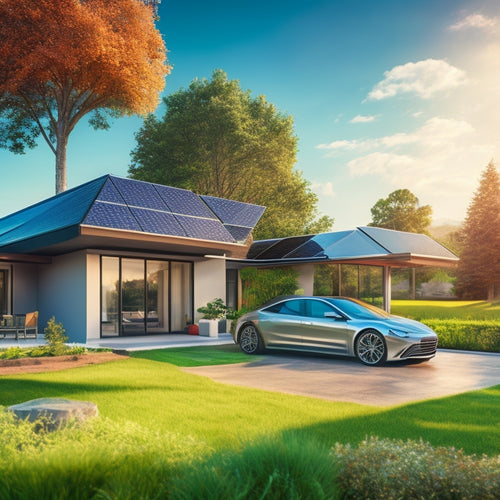
Maximizing Your Solar Setup Efficiency for Optimal Solar Setups
Share
By maintaining your solar panels' condition, enhancing their angles and directions, and implementing strategic energy storage, you can maximize your solar setup's efficiency by up to 25%. Regular inspections and cleaning can detect issues like cracks and dirt buildup, while adjusting panel angles seasonally guarantees peak sun exposure. Monitoring performance data and energy output helps identify unusual patterns, and selecting the right inverter and energy storage solutions can further increase efficiency. By taking these steps, you'll not only reduce costs but also extend your system's lifespan - and there's even more to investigate to get the most out of your solar setup.
Key Takeaways
- Regularly inspect and maintain solar panels to detect issues, clean dirt and debris, and monitor performance to maximize energy output.
- Optimize panel angles, directions, and minimize shading to ensure optimal sun exposure and energy production.
- Implement effective cleaning and maintenance strategies, including soft-bristled brushes and mild soap, to prevent damage and ensure clarity.
- Monitor performance metrics, such as voltage and temperature, to identify patterns and anomalies, and optimize setup efficiency.
- Select high-efficiency inverters, configure settings correctly, and implement proper thermal management to minimize energy losses and ensure grid synchronization.
Assessing Your Solar Panel Condition
When evaluating the overall performance of your solar setup, it's essential to start with the foundation: your solar panels. As the core component of your system, their condition markedly impacts energy production. Evaluating their state is important to identify potential issues and optimize their performance.
You should inspect your panels regularly to detect any degradation signs, such as cracks, yellowing, or hot spots. These signs can indicate a decrease in panel lifespan, which can greatly affect your system's overall efficiency. A typical solar panel lifespan ranges from 25 to 30 years, but degradation can occur earlier if not properly maintained.
Check for signs of dirt, debris, or shading, which can reduce energy output. Make sure that your panels are clean and free from obstacles.
Additionally, monitor your system's performance data to identify any unusual patterns or drops in energy production. By regularly evaluating your solar panel condition, you can identify and address potential issues, ultimately maximizing your solar setup's efficiency.
Optimizing Panel Angles and Directions
Maximizing your solar panels' angles and directions is crucial for utilizing the maximum amount of energy from the sun. This guarantees you get the best possible performance from your solar setup.
To achieve ideal sun exposure, consider the following:
-
Latitude-based tilt: Adjust your panel tilt based on your location's latitude to maximize energy production.
-
Seasonal adjustments: Tilt your panels at an angle that accounts for seasonal changes in the sun's position to maintain ideal energy output.
-
Shading minimization: Position your panels to minimize shading from surrounding objects, such as trees or buildings.
- Directional orientation: Face your panels towards the direction that receives the most sunlight throughout the day, typically south in the northern hemisphere.
Cleaning and Maintenance Strategies
You'll want to develop a cleaning and maintenance strategy that guarantees your solar setup operates at peak efficiency.
Regularly removing dust and debris from your panels is essential, as even a thin layer of dirt can considerably reduce energy output.
Dust and Debris Removal
How much energy are your solar panels really producing? You might be surprised to find out that dust and debris are quietly reducing your solar setup's efficiency.
In fact, a dirty solar panel can decrease energy output by up to 25%! Regular cleaning is essential to maximize your solar setup's performance.
To minimize the debris impact on your solar panel cleaning, follow these vital steps:
-
Inspect your solar panels regularly: Look for dirt, dust, leaves, and other debris that might be obstructing sunlight.
-
Use a soft-bristled brush or soft cloth: Gently sweep away loose debris, taking care not to scratch the panels.
-
Mix a mild soap with warm water: Dip a soft cloth into the solution, wring it out thoroughly, and wipe down the panels.
- Rinse with distilled water: Use a clean, lint-free cloth to remove any remaining soap residue and dry the panels.
Regular Inspection Schedules
Establishing a regular inspection schedule is essential to maintaining your solar setup's efficiency. Regular maintenance helps identify and address potential issues before they become major problems, ensuring your system operates at its best. By staying on top of inspections, you'll enjoy numerous inspection benefits, including extended system lifespan, improved performance, and reduced repair costs.
Here's a breakdown of what you should inspect and how often:
| Component | Inspection Frequency |
|---|---|
| Panels | Every 6 months |
| Mounting system | Every 12 months |
| Inverters | Every 3 months |
| Electrical connections | Every 6 months |
| Monitoring system | Every 3 months |
Monitoring Performance and Energy Output
You'll want to keep a close eye on your solar setup's performance to guarantee it's running at maximum efficiency.
That's where energy output analytics and performance tracking tools come in, providing you with the data you need to identify areas for improvement.
Energy Output Analytics
About 80% of your solar setup's energy output is directly tied to its performance, making real-time monitoring essential for ideal efficiency. This is where energy output analytics comes in - it's the process of collecting and analyzing data to optimize your solar setup's performance.
By monitoring your energy output, you can identify areas for improvement, reduce energy consumption, and guarantee seamless grid integration.
Here are four key aspects to focus on:
-
Energy production: Track your solar setup's energy production in real-time to identify patterns and anomalies.
-
System performance: Monitor your system's performance metrics, such as voltage, current, and temperature, to detect potential issues.
-
Energy consumption: Analyze your energy consumption patterns to optimize your setup's performance and reduce waste.
- Grid integration: Ascertain your solar setup is integrated with the grid efficiently, and adjust your energy output accordingly.
Performance Tracking Tools
Your solar setup's performance tracking relies heavily on advanced tools that provide real-time observations into its energy output and overall performance. These tools enable you to monitor your system's performance benchmarks, comparing them to industry standards and identifying areas for improvement.
By leveraging performance tracking tools, you can refine your solar setup's efficiency, ensuring it operates at peak levels. User experiences have shown that real-time monitoring greatly improves system performance.
You can pinpoint issues, such as underperforming panels or inverter malfunctions, and address them promptly. This proactive approach minimizes downtime, reducing the likelihood of energy losses and associated revenue decreases.
Additionally, performance tracking tools provide comprehensive analytics, allowing you to make data-driven decisions that enhance your solar setup's energy output.
Real-Time Data Insights
Through real-time data observations, your solar setup's performance and energy output come into sharp focus. You can now identify areas of improvement, optimize energy production, and make data-driven decisions.
Real-time data revelations enable you to:
-
Monitor energy output: Track your solar setup's energy production in real-time, allowing you to identify trends and anomalies.
-
Analyze performance metrics: Evaluate your setup's efficiency, power output, and other key performance indicators to identify areas for improvement.
-
Utilize data visualization: Convert complex data into actionable understanding through interactive dashboards and graphs, enabling you to make informed decisions.
- Leverage predictive analytics: Forecast energy production, optimize energy storage, and plan for maintenance using advanced algorithms and machine learning models.
Energy Storage and Battery Efficiency
In tandem with utilizing solar energy, efficient energy storage and battery management play a critical role in maximizing the overall performance of your solar setup.
As you endeavor to optimize your solar setup, it's crucial to contemplate the importance of energy storage and battery efficiency. You want to guarantee that the energy you generate is stored effectively and efficiently, allowing you to access it when needed.
To achieve this, you'll need to focus on energy management. This involves monitoring and controlling the flow of energy between your solar panels, batteries, and appliances. By doing so, you can optimize energy usage, reduce waste, and prolong battery longevity.
A well-designed energy management system will also help you identify areas of inefficiency, allowing you to make data-driven decisions to improve your setup.
When selecting energy storage solutions, contemplate factors such as depth of discharge, round-trip efficiency, and cycle life. These metrics will give you a clear understanding of your battery's performance and help you make informed decisions about your energy management strategy.
Inverter Selection and Configuration
Most solar setups rely on at least one inverter to convert the DC power generated by your panels into usable AC power for your appliances. When selecting an inverter, you'll need to take into account the type that best suits your system. There are string inverters, microinverters, and power optimizers, each with their own advantages and disadvantages.
To guarantee peak performance, you'll need to configure your inverter correctly. Here are some key factors to take into account:
-
Efficiency ratings: Look for inverters with high efficiency ratings to minimize energy losses.
-
Configuration settings: Make certain your inverter is set up to optimize energy production based on your system's specific needs.
-
Grid synchronization: Make sure your inverter is compatible with the grid's frequency and voltage requirements.
- Thermal management: Proper thermal management is essential to prevent overheating and guarantee reliable operation.
Additionally, evaluate factors like voltage regulation, load balancing, and installation standards to verify your inverter is installed correctly and meets local regulations.
Upgrading and Expanding Your System
Your solar setup is a lively system that evolves with your energy needs. As your energy requirements change over time, upgrading and expanding your system becomes vital to maintain peak performance.
When considering upgrades, system compatibility is significant. Confirm that any new components integrate seamlessly with your existing setup to avoid inefficiencies and potential system failures.
Conduct a thorough expansion cost analysis to determine the most cost-effective approach. This involves evaluating the current system's capacity, identifying areas for improvement, and reviewing the costs of upgrading or adding new components.
Be mindful of the potential impact of upgrades on your system's overall performance, including factors such as inverter capacity, panel efficiency, and energy storage capabilities.
Frequently Asked Questions
Can I Mix Old and New Solar Panels in the Same Setup?
You can mix old and new solar panels, but you'll need to guarantee panel compatibility and consider efficiency implications. Check voltage, current, and power ratings to avoid mismatches, and be prepared for potential energy losses and reduced system efficiency.
Do Solar Panels Work During a Power Outage?
You'll stay powered during outages with grid independence, achieved by pairing your solar panels with battery storage, allowing you to store excess energy generated during the day for nighttime or emergency use.
Will Trees Surrounding My House Affect Solar Panel Performance?
You're wondering if trees surrounding your house will affect solar panel performance. Yes, they will; shading from trees can considerably reduce energy output. Consider tree trimming to minimize shading impact and optimize your solar panel's energy production.
How Long Does It Take to Recoup My Solar Panel Investment?
You'll want to conduct an investment analysis to determine your solar payback period, which varies depending on factors like system size, local incentives, and electricity rates; on average, it takes around 5-7 years to recoup your investment.
Can I Install Solar Panels on a Metal or Asphalt Roof?
You can install solar panels on a metal or asphalt roof, but you'll need to ascertain the roof's structural integrity and meet specific installation requirements, such as secure fastening and compatible roofing materials, to guarantee a safe and efficient setup.
Conclusion
As you fine-tune your solar setup, remember that every watt saved is a ray of sunshine captured. Your optimized system is like a skillfully crafted puzzle, each piece working in harmony to maximize energy production. By following these expert tips, you've changed your solar setup into a powerhouse, utilizing the sun's energy with precision and efficiency. Now, bask in the glow of your eco-friendly accomplishment, knowing you're shining brighter than ever.
Related Posts
-

What Solar Panels Work Best With EVS Online?
When shopping for solar panels online to power your electric vehicle, look for high-efficiency models that can withst...
-

Why Higher Upfront Costs Are Worth It
You pay a premium for high-quality, energy-efficient products, but they're worth it. With durability testing ensuring...
-

Step-by-Step Guide to Converting Your Vehicle to EV
You'll begin by evaluating your vehicle's conversion potential, analyzing its weight, aerodynamics, and powertrain co...


